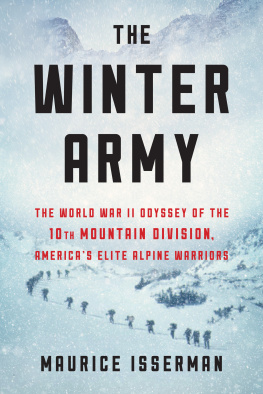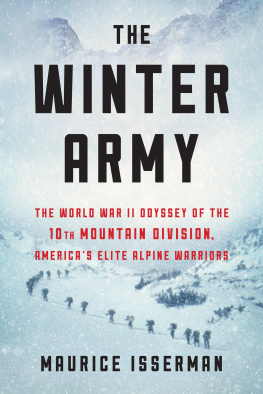Copyright 2019 by Maurice Isserman
All rights reserved
For information about permission to reproduce selections from this book, write to or to Permissions, Houghton Mifflin Harcourt Publishing Company, 3 Park Avenue, 19th Floor, New York, New York 10016.
hmhbooks.com
Library of Congress Cataloging-in-Publication Data
Names: Isserman, Maurice, author.
Title: The winter army : the World War II odyssey of the 10th Mountain Division, Americas elite alpine warriors / Maurice Isserman.
Other titles: World War II odyssey of the 10th Mountain Division, Americas elite alpine warriors
Description: Boston : Houghton Mifflin Harcourt, 2019. | Includes bibliographical references and index.
Identifiers: LCCN 2019009836 (print) | LCCN 2019012409 (ebook) | ISBN 9781328871190 (ebook) | ISBN 9781328871435 (hardcover)
Subjects: LCSH: United States. Army. Mountain Division, 10thHistory. | World War, 19391945Regimental historiesUnited States. | Mountain troopsUnited StatesTraining of. | Skis and skiingUnited StatesHistory. | World War, 19391945CampaignsItaly. | World War, 19391945Mountain warfare. | Mountain warfareHistory20th century.
Classification: LCC D 769.3 10th (ebook) | LCC D 769.3 10th .187 2019 (print) | DDC 940.54/1273dc23
LC record available at https://lccn.loc.gov/2019009836
Cover design by Brian Moore
Cover images Judith Evita Ruland / eyeem / Getty Images (mountain / snow); 10th Mountain Division Resource Center, Denver Public Library (soldiers)
Author photograph courtesy of the author
v1.1019
Epigraph from A Farewell to Arms by Ernest Hemingway. Copyright 1929 by Charles Scribners Sons. Copyright renewed 1957 by Ernest Hemingway. Reprinted with the permission of Scribner, a division of Simon & Schuster, Inc. All rights reserved.
This book is dedicated to the memory of my parents, Flora and Jack Isserman, who would have laughed at being described as part of any greatest generation but certainly were to me.
Also to two other personal heroes of my acquaintance, Donald B. Potter, H Company, 85th Mountain Infantry Regiment, 10th Mountain Division, my colleague for many years on the faculty at Hamilton College, and Harris Dusenbery, HQ Company, 1st Battalion, 86th Mountain Infantry Regiment, 10th Mountain Division, fellow Reed College alumnus, in his case Class of 1936.
In the late summer of that year we lived in a house in a village that looked across the river and the plain to the mountains. In the bed of the river there were pebbles and boulders, dry and white in the sun, and the water was clear and swiftly moving and blue in the channels. Troops went by the house and down the road and the dust they raised powdered the leaves of the trees. The trunks of the trees too were dusty and leaves fell early that year and we saw the troops marching along the road and the dust rising and leaves, stirred by the breeze, falling and the soldiers marching and afterward the road bare and white except for the leaves.
The plain was rich with crops; there were many orchards of fruit trees and beyond the plain the mountains were brown and bare. There was fighting in the mountains and at night we could see flashes from the artillery. In the dark it was like summer lightning, but the nights were cool and there was not the feeling of a storm coming.
Ernest Hemingway, A Farewell to Arms, 1929
Thanks to the failure of the press, and to the stupidity of Hollywood, the Home Front has no real conception of war, and only by [soldiers] letters home can the truth be made known.
Sergeant Denis Nunan, C Company, 87th Mountain Infantry Regiment, 10th Mountain Division, to his mother from Castel dAiano, Italy, March 23, 1945
Introduction: Always Forward
On February 16, 1945, Major General George Price Hays, Commander of the US Armys 10th Mountain Division, spoke to men from the units 85th Regiment. In three days they would lead the attack on dug-in German defenders holding the high ground of Mount Belvedere in Italys northern Apennines. Although new to combat, the 10th Division soldiers were uniquely qualified for the audacious mission they were being assigned.
General Hays was a seasoned soldier. As a young officer in 1918 he had been awarded a Medal of Honor in France, and in the current war had commanded artillery units in fighting in both Italy and France before taking command of the 10th the previous autumn. Hays was wiry, weather-beaten, and plainspoken, and reminded one of the young soldiers gathered to hear him on a mountain hillside near Belvedere of a tough old cowhand.
The men he addressed were well trained, fit, and eager to join the fight against the Nazi war machine. But unlike their commander, they were unseasoned. Their division, some of whose members had been training for combat for three full years, was the next to last the US Army would send to fight in Europe, arriving in Naples in late December 1944 and early January 1945. Their first weeks as frontline soldiers had been relatively uneventful, with little real fighting and few casualties. And yet the general, who was not given to flattery or flowery words, told them they were the finest troops Ive ever been associated with. He counted on their rigorous training and their exceptional esprit de corps to see them through the coming days of fighting. And because of that, he was going to do something he had never done before as a senior combat commander: personally discuss the details of an upcoming attack with the enlisted men, NCOs, and junior officers who would risk their lives to carry out the assignment ahead of them. Hayss own son was serving as a platoon leader in another regiment in the 10th Mountain Division, the 87th, and was scheduled to take part in the attacka fact he decided not to share with those he addressed now.
Standing before them in a large natural outdoor amphitheater, Hays described the plans for the next few days. As he spoke, he pointed out enemy positions on a large map, his voice and leather-gloved hand cutting through the cold mountain air.
Mount Belvedere and adjoining peaks were the key to the German defensive line in the North Apennines, and their capture was essential to the success of the Allied offensive in Italy in the fighting to come in the spring. Twice before, other divisions had attempted to secure the position and failed. Now it was the 10ths turn. Hays gave the men some stern advice on what to expect and how to conduct themselves. Most important, he stressed the need for speed and audacity: You must continue to move forward. Never stop. If your buddy is wounded, dont stop to help him. Continue to move forward, always forward, always forward.
Dan Kennerly, a twenty-two-year-old private from rural Georgia, serving in D Company of the 85th Mountain Infantry Regiment, recorded the gist of Hayess words in the diary he kept in Italy. Before enlisting, he had spent a season playing football for the University of Georgia. Now he was moved to comment on the eve of his first battle, The General would make a hell of a football coach.
Private Jack R. Smolenske, from Denver, Colorado, twenty years old and serving in Headquarters Company, 3rd Battalion of the 85th, gave a briefer account of the generals talk in an entry the following day in his own diary: Saturday, February 17, 1945: Gen. Hays gave us the dope for the attack on Mt. Belvedere. We move up after dark. No one fires but special men. Must be on top at dawn no matter what. It looks bad.
Smolenske was right. It would be badmuch worse, in terms of death and maiming and horror, than Smolenske and his comrades could then imagine. Other Allied divisions had tried and failed to gain those heights before without success. But the men of the 10th made it to the summit of Belvedere on February 20, moving on to adjacent peaks, and holding the heights against ferocious German counterattacks over the next five days.









